
Canning Diced or Crushed Tomatoes, From Fresh Tomatoes - Easy and Illustrated!
How to Can Fresh Diced or Crushed Tomatoes with a Water Bath Canner!
Click here for a PDF print version of this page.
Making
canned diced or crushed tomatoes is something easy to do and will make your
tomato dishes taste so much better. This is ideal when you have a surplus
of tomatoes from you garden, at the end of the summer, when the tomatoes are
smaller, have blemishes and aren't as suitable for canning whole or eating
fresh.
Home-canned diced or crushed tomatoes have been a tradition for many generations. In the middle of the winter, you can use the diced or crushed tomatoes to make a fresh spaghetti sauce, lasagna, chili, or other tomato-based meals for that fresh garden taste.
Here's how to do it, in easy steps and completely illustrated. This method is so easy, ANYONE can do this! It's a great thing to do with your kids!
And if you'd rather can your tomatoes whole or freeze your tomatoes, see this page!
Ingredients and Equipment
|
|
Process - How to Make Home Canned Diced or Crushed Tomatoes from Fresh Tomatoes
 Step
1 - Selecting the tomatoes
Step
1 - Selecting the tomatoes
It's fun to go pick your own and you can obviously get better quality tomatoes!
At right is a picture of tomatoes from my garden - they are so much better than anything from the grocery store. And if you don't have enough, a pick-your-own farm is the pace to go! At right are 4 common varieties that will work:
| Top left: Beefsteak | Top right: Lemon Boy, yellow |
| Bottom left: Roma, paste-type | Bottom right: Better Boy |
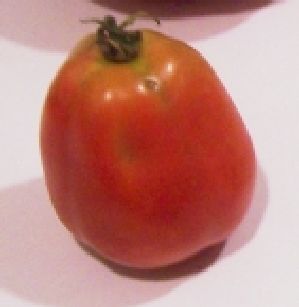 The
picture at right shows the best variety of tomato to use: Roma; also
called paste tomatoes. They have fewer sides, thicker, meatier
walls, and MUCH less water.
And that means thicker sauce in less cooking time!
The
picture at right shows the best variety of tomato to use: Roma; also
called paste tomatoes. They have fewer sides, thicker, meatier
walls, and MUCH less water.
And that means thicker sauce in less cooking time!
Also, you don't want mushy, bruised or rotten tomatoes!
For thin sauce - An average of 35 pounds is needed per canner load of 7 quarts; an average of 21 pounds is needed per canner load of 9 pints. A bushel weighs 53 pounds and yields 10 to 12 quarts of sauce-an average of 5 pounds per quart.
For thick sauce - An average of 46 pounds is needed per canner load of 7 quarts; an average of 28 pounds is needed per canner load of 9 pints. A bushel weighs 53 pounds and yields 7 to 9 quarts of sauce-an average of 6 pounds per quart.
Step 2 - Get the jars and lids sanitizing
 The
dishwasher is fine for the jars; especially if it has a "sanitize" cycle.
I get that going while I'm preparing everything else, so it's done by the
time I'm ready to fill the jars. If you don't have a dishwasher,
submerge the jars in a large pot (the canner itself) of water and bring it
to a boil.
The
dishwasher is fine for the jars; especially if it has a "sanitize" cycle.
I get that going while I'm preparing everything else, so it's done by the
time I'm ready to fill the jars. If you don't have a dishwasher,
submerge the jars in a large pot (the canner itself) of water and bring it
to a boil.
Be sure to let it go through the rinse cycle to get rid of any soap!
Get the canner heating up
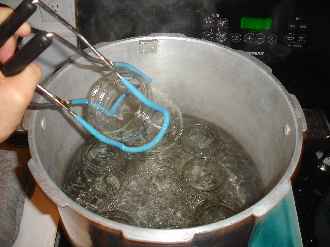 Fill
the canner about 1/2 full of water and start it heating (with the lid on).
Fill
the canner about 1/2 full of water and start it heating (with the lid on).
Get a the medium pot of water or tomato juice heating
This is also a good time to get your 1 quart of tomato juice and/or water boiling (you will use it to fill any air spaces in the jars in step 6).
Start the water for the lids
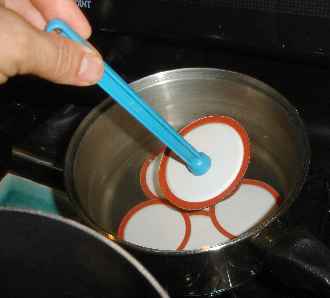
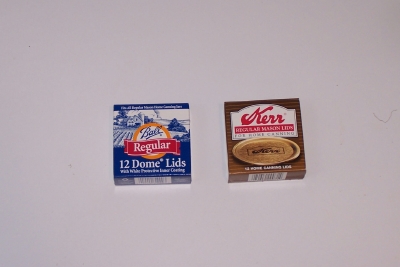 Put
the lids into a pan of hot, but not quite boiling water for at least several minutes.
Note: everything gets sanitized in the water bath (step 7) anyway, so this just
helps to ensure there is no spoilage later!)
Put
the lids into a pan of hot, but not quite boiling water for at least several minutes.
Note: everything gets sanitized in the water bath (step 7) anyway, so this just
helps to ensure there is no spoilage later!)
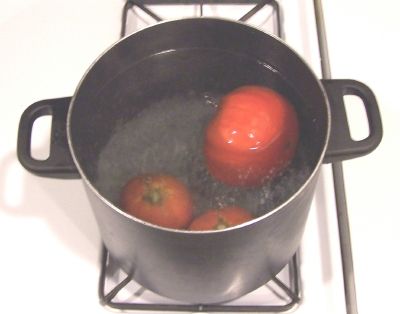
Step 3 - Removing the tomato skins
Here's a trick you may not know: put the tomatoes, a few at a time in a large pot of boiling water for no more than 1 minute (30 - 45 seconds is usually enough)
then....
Plunge them into a waiting bowl of ice water.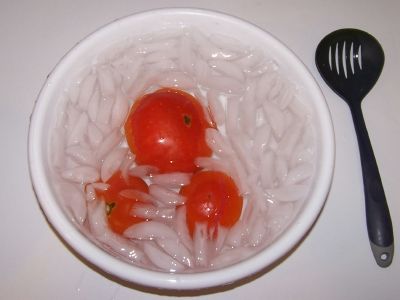
This makes the skins slide right off of the tomatoes! If you leave the skins in, they become tough and chewy in the sauce, not very pleasant.
Step 4 - Removing the skins, bruises and tough parts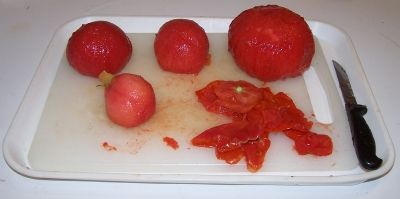
The skins should practically slide off the tomatoes. Then you can cut the tomatoes in quarters and remove the tough part around the stem and any bruised or soft parts.
Why remove the skins? They become tough when you cook them! Some people use a juicer and then cook the resultant juice down. It takes more time, but there's nothing wrong with that approach.
Step 5 - Removing seeds and water
After you have peeled the skins off the tomatoes, cut the tomatoes in half. Now we need to remove the seeds and excess water.

Step 6 - Squeeze of the seeds and water
Just like it sounds: wash your hands then squeeze each tomato and use
your finger or a spoon to scoop and shake out most of the seeds. You
don't need to get fanatical about it; removing just most will do. Another
way to do it is to cut each tomato in half, across it, instead of
lengthwise. Then just shake the seeds and juice out.

Step 7 - Combine 1/6 of the tomatoes and bring to a gentle simmer
Combine
one-sixth of the tomatoes in a big pot, crushing them with a wooden
mallet or spoon as they are added to the pot. This will exude juice.
There's generally no need to add liquid, most types of tomatoes have so
much water.
Continue heating the tomatoes, stirring to prevent burning.
Once the tomatoes are boiling, gradually add remaining quartered tomatoes, stirring constantly These remaining tomatoes do not need to be crushed. They will soften with heating and stirring. As they cook, the tomatoes will fall apart into sauce with out much need of crushing or mushing!
Step 8 - Continue to add the rest of the tomatoes
Continue until all tomatoes are added. Then boil gently for 5 minutes.
Step 9 - Add 2 Tablespoons of lemon juice and liquid to each empty jar
 Before
you fill each jar with tomatoes, add 2 tablespoons of lemon juice per quart jar,
1 per pint jar. This helps to reduce the odds of spoilage and to retain
color and flavor. T
Before
you fill each jar with tomatoes, add 2 tablespoons of lemon juice per quart jar,
1 per pint jar. This helps to reduce the odds of spoilage and to retain
color and flavor. T
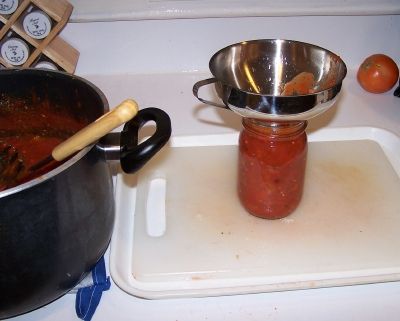 Step
10 - Fill the jars with heated tomatoes
Step
10 - Fill the jars with heated tomatoes
Fill them to within 1/4-inch of the top, seat the lid and hand-tighten the ring around them.
NOTE: if you want to freeze the tomatoes instead, just let the tomatoes cool to room temperature, then fill your freezer containers (I like Ziploc freezer bags in the quart size), fill them completely, eliminate air pockets, seal them and pop them in the freezer. You're done!
Step 11 - Put the lids and rings on
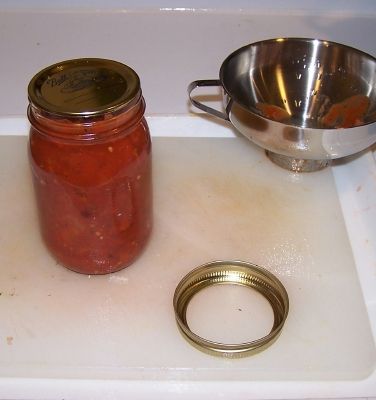 Just
screw them on snugly, not too tight. If the is any tomato on the surface
of the lip of the jar, wipe it off first with a clean dry cloth or paper towel.
Just
screw them on snugly, not too tight. If the is any tomato on the surface
of the lip of the jar, wipe it off first with a clean dry cloth or paper towel.
Be sure the contact surfaces (top of the jar and underside of the ring) are clean to get a good seal!
Step 12 - Boil the jars in the water bath canner
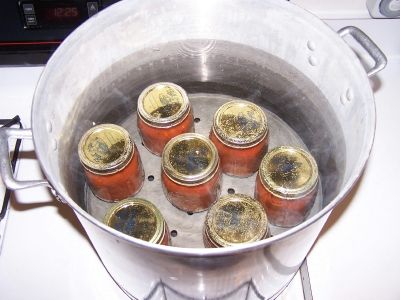 Put
them in the canner and keep them covered with at least 1 inch of water.
Keep the water boiling. Process the jars in a boiling-water bath for 35
minutes for pints and 40 minutes for quarts. Remember to adjust the time
if you are at a different altitude other than sea level! Pressure
canners work better for tomato sauce and other low acid foods - you will get
less spoilage with a Pressure Canner.
Put
them in the canner and keep them covered with at least 1 inch of water.
Keep the water boiling. Process the jars in a boiling-water bath for 35
minutes for pints and 40 minutes for quarts. Remember to adjust the time
if you are at a different altitude other than sea level! Pressure
canners work better for tomato sauce and other low acid foods - you will get
less spoilage with a Pressure Canner.
I prefer a Pressure Canner as the higher temperatures and shorter cooking time result in better flavor and less spoilage. For more information or to order one, click on Pressure Canners. The recipe and directions for pressure canning tomatoes are coming.
|
Recommended process time for /b> Standard Diced or Crushed Tomatoes in a boiling-water canner. |
|||||
| Process Time at Altitudes of | |||||
| Style of Pack | Jar Size | 0 - 1,000 ft | 1,001 - 3,000 ft | 3,001 - 6,000 ft | Above 6,000 ft |
| Hot | Pints | 35 min | 40 | 45 | 50 |
| Quarts | 40 | 45 | 50 | 55 | |
SStep 13 - Done
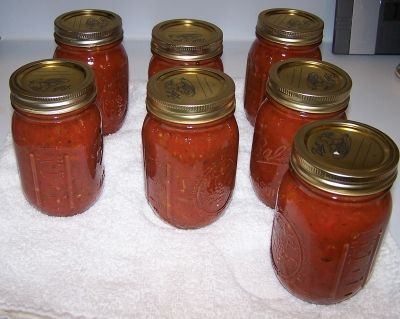 Lift
the jars out of the water and let them cool without touching or bumping
them in a draft-free place (usually takes overnight) You can then
remove the rings if you like, but if you leave them on, at least loosen
them quite a bit, so they don't rust in place due to trapped moisture.
Once the jars are cool, you can check that they are sealed verifying that
the lid has been sucked down. Just press in the center, gently, with your
finger. If it pops up and down (often making a popping sound), it is not
sealed. If you put the jar in the refrigerator right away, you can still
use it. Some people replace the lid and reprocess the jar, then that's a
bit iffy. If you heat the contents back up, re-jar them (with a new lid)
and the full time in the canner, it's usually ok.
Lift
the jars out of the water and let them cool without touching or bumping
them in a draft-free place (usually takes overnight) You can then
remove the rings if you like, but if you leave them on, at least loosen
them quite a bit, so they don't rust in place due to trapped moisture.
Once the jars are cool, you can check that they are sealed verifying that
the lid has been sucked down. Just press in the center, gently, with your
finger. If it pops up and down (often making a popping sound), it is not
sealed. If you put the jar in the refrigerator right away, you can still
use it. Some people replace the lid and reprocess the jar, then that's a
bit iffy. If you heat the contents back up, re-jar them (with a new lid)
and the full time in the canner, it's usually ok.
This document was adapted from the "Complete Guide to Home Canning," Agriculture Information Bulletin No. 539, USDA, revised 1994.hr>
Frequently Asked Questions about Canning Diced or Crushed Tomatoes
Why do my tomatoes separate from the liquid?
A frequent problem is the separation of water from the tomatoes. Why does the water separate from the solids in tomatoes?
Scenario 1 - liquid at the top and solids at the bottom
Home canned tomatoes, tomato juice, and diced or crushed tomatoes with liquid at the top and solids at the bottom is quite normal. It only reflects that the juice was made prior to heating. For example, the tomatoes were chopped, run through the steamer, sieve, or food mill while still raw and prior to heating.
As soon as they are chopped or crushed, enzymes start to break down the pectin that helps to hold tomato cells together. The enzyme that causes separation is activated by exposure to air and inactivated by heat. In commercial production, tomatoes are flash heated nearly to boiling in a matter of seconds, using equipment not available to consumers. Because the pectin holding tomato cells together is not exposed to air when cold, it remains intact, and a thick bodied, homogeneous juice is produced.
The solution is to leave tomatoes whole or in large chunks (do not chop). Heat before chopping or juicing to minimize the separation.
The best way to do that at home is to heat quartered tomatoes quickly to boiling temperatures WHILE crushing. You can also heat the blanched, peeled whole tomatoes in the microwave, then crush them!
Make sure the mixture boils constantly and vigorously while you add the remaining tomatoes. Simmer 5 minutes after all tomatoes are added, before juicing. If you are not concerned about juice separating, simply slice or quarter tomatoes into a large saucepan. Crush, heat and simmer for 5 minutes before juicing.
Scenario 2 - liquid at the bottom and solids at the top (note the photo is step 10)
What about the reverse: liquid at the bottom and solids at the top? That indicates too much preheating (more than 5 minutes). Pectin breaks down when it is overheated; then separation results. If separation occurs, just shake the jar before opening or Decant the water off.
References: Ohio State University
What did I do wrong if my jars spoil?
Tomatoes are a borderline acid / low acid fruit (see this page about tomato acidity for more information) - adding lemon juice helps, processing at least 35 minutes in the water bath canner, or better still, using a Pressure Canner almost eliminates spoilage. If you don't have a pressure canner, you must boost the acid level of the sauce, by adding 2 tablespoons of lemon juice or 1/2 teaspoon of citric acid per quart of sauce.
Other Equipment:
|
From left to right:
|
Canning Supplies Starter Kit - Canning Jar Lifter, Canning funnel, Scissor Tongs, more |
 |
| McSunley 21.5 quart Water Bath Canner, Stainless Steel See here for related tools, equipment, supplies on Amazon See here for related tools, equipment, supplies on Amazon See here for related tools, equipment, supplies on Amazon 
|
Home Canning KitsThis is the same type of standard canner that my grandmother used
to make everything from applesauce to jams and jellies to tomato and
spaghetti sauce. This complete kit includes everything you need and lasts
for years: the canner, jar rack, Jar grabber tongs, lid lifting wand, a
plastic funnel, labels, bubble freer, and the bible of canning, the Ball
Blue Book. It's much cheaper than buying the items separately. You will never need anything else except jars & lids! To see more canners, of different styles, makes and prices, click here!For
more information and current pricing: |
Summary - Cost of Making Homemade Canned Diced Tomatoes - makes 7 pint jars, 16 oz each* |
||||
| Item | Quantity | Cost in 2008 | Source | Subtotal |
| Tomatoes | 20 - 25 lbs (to make about 16 cups of prepared tomato) | free from the garden, or $0.50 cents at a PYO | Garden | $0.00 |
| Canning jars (quart size, wide mouth), includes lids and rings | 7 jars | $8.00/dozen | Grocery stores, like Publix, Kroger and Safeway and local "big box" stores; sometimes Big Lots and even hardware stores | $4.50 |
| Lemon juice | 14 Tablespoons | $0.50 | Grocery store | $0.50 |
| Total | $5.00 total or about $0.72 per jar INCLUDING the jars - which you can reuse! |
|||
| * - This assumes you already have the pots, pans, ladles,, and reusable equipment. Note that you can reuse the jars! Many products are sold in jars that will take the lids and rings for canning. For example, Classico Spaghetti sauce is in quart sized jars that work with Ball and Kerr lids and rings. Note that the Classico's manufacturer does not recommend reuse of their jars: see what they have to say on this page: | ||||
Looking for canning equipment and supplies?
Water bath canner with a jar rack
Pressure canners for gas, electric and induction stoves: Presto 23Qt or T-fal 22Qt
Canning scoop (this one is PERFECT)
Ball Blue book (most recent version)
Jars: 8oz canning jars for jams
Find Other types of farms:
Farm markets and roadside stands
Road trips and camping resources
Local Honey, apiaries, beekeepers
Consumer fraud and scams information
Home canning supplies at the best prices on the internet!
Maple Syrup Farms, sugarworks, maple syrup festivals
Environmental information and resources
Farms For Your Event for birthday parties, weddings, receptions, business meetings, retreats, etc.
Festivals - local fruit and vegetable festivals
Get the
most recent version of
the Ball Blue Book
With this Presto 23 quart pressure canner and pressure cooker, you can "can" everything, fruits, vegetables, jams, jellies, salsa, applesauce, pickles, even meats, soups, stews. Model 01781

You can make jams, jellies, can fruit, applesauce, salsa and pickles with water bath canners, like this Granite Ware 12-Piece Canner Kit, Jar Rack, Blancher, Colander and 5 piece Canning Tool Set

